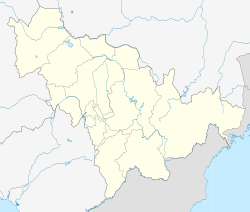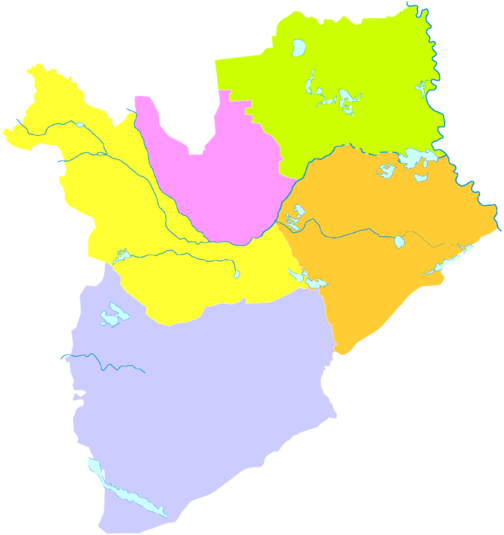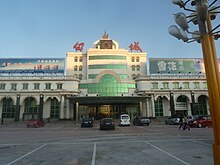Baicheng (original) (raw)
"Pai-Ch'eng" can also refer to the ruins of the former capital of Huining Prefecture.
Prefecture-level city in Jilin, People's Republic of China
| Baicheng 白城市 | |
|---|---|
| Prefecture-level city | |
 Baicheng Station Square Baicheng Station Square |
|
 Location of Baicheng City (yellow) in Jilin (light grey) Location of Baicheng City (yellow) in Jilin (light grey) |
|
  BaichengLocation of the city centre in Jilin BaichengLocation of the city centre in Jilin |
|
| Coordinates (Baicheng municipal government): 45°37′12″N 122°50′17″E / 45.620°N 122.838°E / 45.620; 122.838 | |
| Country | People's Republic of China |
| Province | Jilin |
| Incorporated (town) | 1915 |
| Incorporated (city) | 1958 |
| City seat | Taobei District |
| County-level divisions | 5 |
| Government | |
| • Type | Prefecture-level city |
| • CPC Baicheng Secretary | Li Jinxiu (李晋修) |
| • Mayor | An Guiwu (安桂武) |
| Area | |
| • Prefecture-level city | 25,683 km2 (9,916 sq mi) |
| • Urban (2017)[1] | 67.50 km2 (26.06 sq mi) |
| • Districts[1] | 2,568.8 km2 (991.8 sq mi) |
| Elevation | 154 m (505 ft) |
| Population (2010)[2] | |
| • Prefecture-level city | 2,033,058 |
| • Density | 79/km2 (210/sq mi) |
| • Urban (2020)[1] | 332,826 |
| • Districts[1] | 508,000 |
| GDP[3] | |
| • Prefecture-level city | CN¥ 70 billionUS$ 11.2 billion |
| • Per capita | CN¥ 35,479US$ 5,696 |
| Time zone | UTC+8 (China Standard) |
| Postal code | 137000 |
| Area code | 0436 |
| ISO 3166 code | CN-JL-08 |
| Licence plates | 吉G |
| Website | www.bc.jl.gov.cn |
Baicheng (Chinese: 白城; pinyin: Báichéng; lit. 'White City') is a prefecture-level city in the northwestern part of Jilin province, People's Republic of China, bordering Inner Mongolia to the north and west and Heilongjiang to the east and northeast. At the 2010 census, 2,033,058 people lived within its administrative area of 25,683 km2 (9,916 sq mi).[2]
The Night View of Baicheng
The area around present day Baicheng was a nomadic area which was inhabited by several nomad tribes in Northeast China as early as the Late Neolithic Age, including the Eastern Hu, the Xianbei, the Fuyu, and the Khitans once inhabited the area. During the Liao Dynasty, Baicheng was the political center of four emperors, including Emperor Shengzong, Emperor Xingzong, Emperor Daozong, and Emperor Tianzuo, as the seat of the local government was located at Chengsijiazi Ancient fort in today's Taobei District. As Qing Government forsook the settlement of Han Chinese in the 19th century, no farming was allowed until 1902. In 1904 Baicheng became a county going by the name of Jing'an (靖安). In 1914 Jing'an County was renamed Tao'an (洮南). By 1938 it was finally renamed Baicheng, which in Chinese means white town. The name's origin is the Mongolian name of the city Chaghanhot, which also means "white town".[4] Baicheng used to belong to Nenjiang and Heilongjiang province, under the jurisdiction of the former provincial capital Qiqihar. In 1954, with the Heilongjiang Province merged with Songjiang Province, Baicheng was incorporated into Jilin Province.
Baicheng's importance started to increase after a railway from Qiqihar to Siping through Baicheng was constructed in the 1920s. In the 1930s another railway connecting Baicheng to Ulanhot and the mines at Arxan was opened northwestward. These two lines enabled Baicheng to become a regional transportation hub in western Jilin Province. One more rail line connecting Changchun was opened in the mid-1930s as well.[5]
Baicheng is located in the eastern part of the Horqin Grassland, and situated in the northwestern part of Jilin Province. Bordering prefecture cities are:
- Songyuan (SE)
- Qiqihar (N)
- Xingan League (W)
The city's metro area is located 333 kilometres (207 mi) from the provincial capital of Changchun, 218 kilometres (135 mi) from Qiqihar, 448 kilometres (278 mi) from Siping, and 83 kilometres (52 mi) from Ulanhot. The city is located at latitude 44° 13′—46° 18′ N and longitude 121° 38′—124° 22' E. At its greatest width, the city spans 230 kilometres (142.9 mi) from north to south and 211 kilometres (131 mi) from east to west. The total area of the city is 25,683 square kilometres (9,916 sq mi), occupying a mere 13.7% of the provincial area. The eastern part of the Greater Khingan Mountains lies in the northwest of Baicheng. Grassland and wetlands are prominent throughout the city's southeastern part.
Dust storm came to Baicheng in 2001
Baicheng has a rather dry, monsoon-influenced, humid continental climate (Köppen Dwa), with long (lasting from November to March), very cold, windy, but dry winters due to the influence of the Siberian high, and hot, humid summers, due to the East Asian monsoon. The coldest month, January, averages −16.1 °C (3.0 °F), while the warmest month, July, averages 23.5 °C (74.3 °F); the annual mean is 5.5 °C (41.9 °F). More than 70% of the annual precipitation falls from June to August alone. Drought conditions are common in spring and autumn; from 1961 to 2009, there were 31 years with spring drought and 28 with autumn drought.
| Climate data for Baicheng (1991–2020 normals, extremes 1971–2010) | |||||||||||||
|---|---|---|---|---|---|---|---|---|---|---|---|---|---|
| Month | Jan | Feb | Mar | Apr | May | Jun | Jul | Aug | Sep | Oct | Nov | Dec | Year |
| Record high °C (°F) | 5.9(42.6) | 12.8(55.0) | 26.6(79.9) | 33.3(91.9) | 40.0(104.0) | 40.7(105.3) | 38.0(100.4) | 37.7(99.9) | 34.0(93.2) | 29.8(85.6) | 19.3(66.7) | 7.2(45.0) | 40.7(105.3) |
| Mean daily maximum °C (°F) | −8.8(16.2) | −3.0(26.6) | 5.4(41.7) | 15.6(60.1) | 23.1(73.6) | 27.7(81.9) | 29.2(84.6) | 27.7(81.9) | 22.7(72.9) | 13.7(56.7) | 1.3(34.3) | −7.5(18.5) | 12.3(54.1) |
| Daily mean °C (°F) | −15.7(3.7) | −10.3(13.5) | −1.6(29.1) | 8.6(47.5) | 16.6(61.9) | 21.8(71.2) | 24.0(75.2) | 22.0(71.6) | 15.9(60.6) | 6.9(44.4) | −4.8(23.4) | −13.7(7.3) | 5.8(42.4) |
| Mean daily minimum °C (°F) | −21.4(−6.5) | −16.9(1.6) | −8.6(16.5) | 1.1(34.0) | 9.6(49.3) | 15.8(60.4) | 19.0(66.2) | 16.6(61.9) | 9.3(48.7) | 0.8(33.4) | −10.1(13.8) | −18.9(−2.0) | −0.3(31.4) |
| Record low °C (°F) | −38.1(−36.6) | −36.7(−34.1) | −26.0(−14.8) | −13.6(7.5) | −4.4(24.1) | 3.7(38.7) | 8.0(46.4) | 6.6(43.9) | −2.9(26.8) | −19.6(−3.3) | −29.3(−20.7) | −35.1(−31.2) | −38.1(−36.6) |
| Average precipitation mm (inches) | 1.0(0.04) | 2.0(0.08) | 4.2(0.17) | 16.0(0.63) | 38.0(1.50) | 81.9(3.22) | 105.3(4.15) | 70.2(2.76) | 44.0(1.73) | 12.9(0.51) | 4.2(0.17) | 2.7(0.11) | 382.4(15.07) |
| Average precipitation days (≥ 0.1 mm) | 2.1 | 1.6 | 2.7 | 3.9 | 7.4 | 11.6 | 11.6 | 9.3 | 6.6 | 4.0 | 3.1 | 3.4 | 67.3 |
| Average snowy days | 4.1 | 2.9 | 4.0 | 1.2 | 0 | 0 | 0 | 0 | 0 | 1.0 | 4.0 | 5.1 | 22.3 |
| Average relative humidity (%) | 58 | 48 | 40 | 37 | 45 | 59 | 73 | 73 | 62 | 52 | 54 | 59 | 55 |
| Mean monthly sunshine hours | 212.4 | 229.0 | 272.9 | 264.2 | 266.0 | 249.1 | 240.5 | 247.1 | 246.9 | 227.2 | 190.8 | 187.0 | 2,833.1 |
| Percent possible sunshine | 75 | 78 | 73 | 65 | 58 | 53 | 51 | 57 | 67 | 68 | 68 | 69 | 65 |
| Source 1: China Meteorological Administration[6][7] | |||||||||||||
| Source 2: Weather China[8] |
Administrative divisions
[edit]
| Map | ||||||
|---|---|---|---|---|---|---|
 Taobei Zhenlai County Tongyu County Taonan (city) Da'an (city) Taobei Zhenlai County Tongyu County Taonan (city) Da'an (city) |
||||||
| # | Name | Hanzi | Hanyu Pinyin | Population (2003 est.) | Area (km2) | Density (/km2) |
| 1 | Taobei District | 洮北区 | Táoběi Qū | 490,000 | 2,525 | 194 |
| 2 | Da'an City | 大安市 | Dà'ān Shì | 420,000 | 4,879 | 86 |
| 3 | Taonan City | 洮南市 | Táonán Shì | 440,000 | 5,108 | 86 |
| 4 | Zhenlai County | 镇赉县 | Zhènlài Xiàn | 310,000 | 4,695 | 66 |
| 5 | Tongyu County | 通榆县 | Tōngyú Xiàn | 350,000 | 8,476 | 41 |
Textile industry is one of the main pillars of the economy. Agriculture of the area is centred on plantation of soy beans and oil plants. It is home to the Baicheng Weapons Test Centre.[9]
Baicheng Railway Station
Baicheng railway station is a railway hub in western Jilin Province. It is the terminus of the Changchun–Baicheng railway. There are multiple daily departures to other cities including Beijing, Harbin, Changchun, Shenyang, Dalian, Qiqihar, Ulanhot and several other cities in northern provinces of China.
Expressways:
National Highway (GXXX):
Baicheng Chang'an Airport is located in the town of Taohe (洮河) in Taobei District, 16.5 kilometres (10.3 mi) from the city center. It has been under construction since October 26, 2012.[10] The total investment is 480 million yuan.[11] The airport was opened on 31 March 2017, the fifth civil airport in Jilin province.[12] The airport has a runway that is 2,500 meters long and 45 meters wide (class 4C), and a 4,471 square-meter terminal building. It is designed to handle 200,000 passengers and 700 tons of cargo annually by 2020.[12]
 Barnaul, Altai Krai, Russia
Barnaul, Altai Krai, Russia
- ^ a b c d Ministry of Housing and Urban-Rural Development, ed. (2019). China Urban Construction Statistical Yearbook 2017. Beijing: China Statistics Press. p. 50. Archived from the original on 18 June 2019. Retrieved 11 January 2020.
- ^ a b 2010年吉林省第六次全国人口普查主要数据公报 (in Chinese (China)). Jilin Province People's Government. May 2011. Archived from the original on 2011-11-05. Retrieved 2012-01-01.
- ^ 吉林省统计局、国家统计局吉林调查总队 (September 2016). 《吉林统计年鉴-2016》. 中国统计出版社. ISBN 978-7-5037-7899-5. Archived from the original on 2018-04-28. Retrieved 2017-06-05.
- ^ 白城市地方志编纂委员会编 (1993). 白城市志 [_History of Baicheng_]. 中国广播电视出版社. ISBN 7-5043-2568-6.
- ^ "Baicheng - China". Encyclopedia Britannica.
- ^ 中国气象数据网 – WeatherBk Data (in Simplified Chinese). China Meteorological Administration. Retrieved 7 July 2023.
- ^ "Experience Template" 中国气象数据网 (in Simplified Chinese). China Meteorological Administration. Retrieved 7 July 2023.
- ^ 白城 - 气象数据 -中国天气网 (in Chinese). Weather China. Retrieved 28 November 2022.
- ^ Fisher, Richard D. Jr. (February 5, 2019). "Images emerge of new Chinese 8×8 assault gun". Jane's Information Group. Images have emerged showing what appears to be a new Chinese 8×8 assault gun equipped with a 105 mm main armament and a remote-controlled weapon station reportedly being trialled at what local media identified as the Baicheng Weapons Test Centre in northeastern China.
- ^ 白城新空港:长安机场 [A Baicheng Airport: Changan airport]. Government of Jilin Province. 2012-10-30. Archived from the original on 2013-02-15. Retrieved 2013-01-22.
- ^ 白城新空港:长安机场. Government of Jilin Province. 2012-10-30. Archived from the original on 2013-02-15. Retrieved 2013-01-22.
- ^ a b 吉林白城长安机场正式通航. Xinhua. 1 April 2017.

Wikimedia Commons has media related to Baicheng.
![]()
Wikivoyage has a travel guide for Baicheng.


